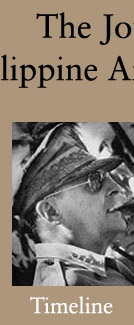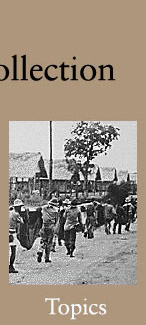
About the Philippine Archives Collection
- About the Collection
- Origins of the Collection
- Guerilla Groups
- List of Series in the Philippine Archives Collection
- For More Information About the Records
The Philippine Archives Collection constitutes an invaluable source of information on the Pacific war during World War II, particularly concerning the treatment of prisoners of war (POWs); military operations in the Philippines, 1941-1942; guerrilla warfare in the Philippines; and conditions in the Philippines under Japanese occupation.
Many of these records have intrinsic value because their form and media are indicative of the shortage of paper in the Philippines from 1941 to 1945.
Rather than War Department forms, these records are on brown paper bags, on the back of letters, sales receipts, court documents, school forms, ledger book papers, evaporated milk can labels, and similar items. Some records, retrieved in 1945, show the effect of being buried to prevent capture during the war.

Various organizations operating in the Philippines created the earliest records in what became the Philippine Archives Collection. After the war, the War Department gathered more materials in the Philippines, Japan, and Korea. The records moved to Kansas City and St. Louis, Missouri, before the National Archives brought them to Washington, DC. The Collection is now maintained at the National Archives and Records Administration in College Park, Maryland.
To a certain extent, the Philippine Archives Collection documents the activities of Southwest Pacific Area (SWPA) and its component parts, but the primary focus of the collection is not at the command level.

The collection’s focus is on the individual men and women who served in military or civilian capacities or in guerrilla units in the Philippines during the period of SWPA control. Among the records are:
- personal histories and diaries;
- unit histories;
- medical and death reports;
- documents on activities within guerrilla units and criminal behavior by guerrillas; and
- accounts of the effort to liberate the Philippine Islands from Japanese control.
These records also provide descriptions of conditions within the camps that held POWs and civilian internees in the Philippines, Japan, and on the Asiatic mainland; accounts of Japanese occupation and atrocities; reports of Japanese unit operations; and diaries and narratives recalling the Bataan death march and POW camp life.
A large portion of the records are:
- applications for pay and benefits based on military or civilian service,
- claims by civilians who were pressed into service to repel the Japanese invasion, and
- claims for compensation by former guerrillas based on their support of the U.S. effort in the Philippines.
Who Collected the Records?

The records in the Philippine Archives Collection originated with a variety of organizations and individuals. Unfortunately their provenance and any original order were lost when the records were brought together and combined with the records of the Recovered Personnel Division ( RPD).
Why Did They Collect the Records?
The U.S. awarded compensation to individuals who had supported U.S. objectives in the Philippines. These records were collected to help determine the validity of claims. A key factor in determining eligibility was an individual’s service record.
Eligibility was easily established for veterans of the Philippine Army, Philippine Scouts, or guerrilla units that were recognized by General Douglas MacArthur. Members of outlaw guerrilla units which consisted of thieves and bandits as well as guerrilla units that sought to eliminate both the American and Japanese presence from the Philippine Islands were not eligible for benefits or compensation.
For deceased claimants an adjudicator made a determination of death, status, and grade under the Missing Persons Act.
About Whom Did They Collect Records?

The RDP gathered personal information on Americans and Filipinos who had supported U.S. objectives or been connected to U.S. activities in the Philippines during World War II, including:
- Americans:
- civilians employed by the Army during the war
- Army personnel
- Prisoners of War (POWs)
- Filipinos:
- members of the Philippine Scouts (established in the early 1900s and since operated as part of the U.S. Army)
- members of the Philippine Army (consisting of Filipinos commanded by U.S. Army officers, organized in 1935 to assemble and train an army for the defense of the future independent Republic of the Philippines)
- members of guerrilla units
See the Alphabetical List of Guerrilla Units and Their File Codes in the Guerrilla Recognition Unit Files for an index of files related to specific guerrilla units. Also available online is the Philippine Archives Collection Glossary of Initialisms, Abbreviations, and Acronyms which defines abbreviated terms that appear in the Alphabetical List of Guerrilla Units and in the Philippine Archives Collection.
Military Personnel Records at the National Personnel Records Center (NPRC), St. Louis receives the Philippine Army and Guerrilla Records files from the U.S. Army Reserve Personnel Command. Read more about requesting Philippine Army and Guerilla Records from NPRC.
Medical and personnel records of individuals who served in the Army of the Philippines are on file at the U.S. Army Reserve Personnel Command, ATTN: Philippines Army Team, 9700 Page Avenue, St. Louis, MO 63132-5200.
Military service personnel files for members of the Philippines Scouts are in the custody of the Military Personnel Records, National Personnel Records Center, 9700 Page Avenue, St. Louis, MO 63132-5100.
The official Filipino guerrilla rosters for World War II are in the custody of the U.S. Army Reserve Personnel Command (ARPC-VS). Inquiries concerning these official rosters or verification of service should be sent to the Commander, ARPC-VS, 9700 Page Avenue, St. Louis, MO 63132-5200.
To learn more about the Journey of the Philippine Archives Collection: See the Timeline, Maps, or Topics page.





